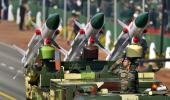'The government must provide more funds to enable the armed forces to fight and win tomorrow's wars,' states Brigadier Gurmeet Kanwal (retd).

At a juncture when the nation is confronting multifarious and rapidly growing threats and challenges, very surprisingly, the funds earmarked for defence expenditure in the Union Budget for financial year 2019-2020 were grossly inadequate to meet the requirements of defence preparedness.
The defence budget for the year ending March 31, 2020 has neither enabled the armed forces to achieve the required levels of battle readiness, nor permitted them to undertake the military modernisation that is necessary to acquire the combat capabilities required for future wars.
For the ministry of defence (MoD), a sum of Rs 305,296 crore (excluding pensions) was earmarked as budgetary estimates for FY 2019-2020.
This represented an increase of approximately 8% over Budget Estimates for FY 2018-2019.
The increase has proved to be inadequate to allow for the prevailing rate of inflation, the annual hike in pay and allowances and the steep fall in the value of the rupee vis-a-vis the US dollar. The exchange rate impacts the price of weapons and equipment that are imported. These comprise approximately 70% of total defence acquisitions.
Other budgetary parameters too continue to show a downward trend.
The total allocation for FY 2019-2020 was less than 1.50% of India's projected GDP for the year, the lowest since the 1962 war with China.
At its peak, during the 1980s, the defence budget was 3.5% of GDP; since then there has been a steady decline.
China and Pakistan respectively spend 2.5% and 3.5% of their GDP on defence.
No matter which yardstick India's defence expenditure is measured by, it is among the lowest in the world.
As a ratio of the total (central) government expenditure, the share of defence is 15.48% for FY 2019-2020.
In Pakistan, it has been varying between 25% to 30% of total government expenditure.
While India has 1.25 soldiers per 1,000 people, China has 2.23 and Pakistan 4.25.
The ratio of capital to revenue expenditure in India's defence budget is far from the ideal of 50:50.
Capital expenditure is that which is incurred on new acquisitions for modernisation, the replacement of obsolete weapons and equipment and expenditure on land and buildings.
The revenue budget is for expenditure on salaries, ammunition, transportation, clothing and maintenance, et al.
In the case of the army, due to the large number of personnel on its rolls, the ratio is as low as 20: 80.
Reportedly, this year the three services faced difficulties even in meeting their previously committed liabilities.
They did not have sufficient funds to pay the instalments due on equipment purchased in previous years.
The net effect of consistently low capital budgets is that obsolescent vintage weapons and equipment in service are degrading combat efficiency and little modernisation is taking place, particularly in the army despite the fact that it gets 56% of the total defence budget.
The worst impact is the inability to acquire precision guided munitions and to modernise the command and control and intelligence, surveillance and reconnaissance systems of the armed forces, even as the three wings of China's People's Liberation Army are modernising at a brisk pace.
The much-trumpeted list of Acceptance of Necessity approvals accorded by the Defence Acquisition Council headed by the defence minister of the Modi 1.0 government for new weapons and equipment acquisition projects worth Rs 150,000 to Rs 200,000 crore over the last five years is meaningless without assured funding support through a non-lapsable roll-on the Defence Modernisation Fund to which the budget on the capital account is added every year.
The pension bill estimated for the current financial year (Rs 112,079.57, BE) is approximately Rs 4,000 crore more than that for FY 2018-2019 (Rs 108,853.30 crore, BE).
This is more than the capital expenditure planned for the year!
Of the total pension bill, about 40% is accounted for by 400,000 non-combatant civilian pensioners of the MoD belonging to the ordance factories, defence PSUs, DRDO and other similar organisations.
Urgent steps need to be taken to adopt innovative measures to reduce the costs of manpower in the armed forces even if the number of personnel in uniform cannot be drastically reduced immediately due to manpower-intensive deployments on the LoC with Pakistan and the LAC with China as well as for counter-insurgency operations in J&K and some of the north eastern states.
The number of civilian personnel paid out of the defence budget must definitely be reduced by privatising most of the ordance factories and other similar organisations.
Parliament's standing committee on defence has repeatedly emphasised that defence expenditure should be progressively raised to 3% of GDP.
India's quest for 'defence on the cheap' can only lead to another debacle like that of 1962.
It has been empirically proved that defence expenditure up to 2.5% to 3% of GDP has a positive impact on the growth rate of a country's economy provided emphasis is laid on self-reliance through indigenous defence production.
For this reason as well, the government must gradually provide more funds for defence to enable the armed forces to acquire the combat capabilities that are necessary to fight and win tomorrow's wars.
Simultaneously, the government must pull out all the stops to genuinely encourage indigenous manufacture of weapons and defence equipment.
India's aspirations to be counted as a regional power capable of maintaining peace and stability in the Indo-Pacific in conjunction with its strategic partners and as a nation striving for world power status, cannot possibly be realised without self-reliance in defence acquisition.
It is to be hoped that Finance Minister Nirmala Sitharaman, herself a former defence minister, will be more forthcoming in providing funds for defence expenditure when she presents the Union Budget on February 1, 2020.
Brigadier Gurmeet Kanwal (retd) is former director, Centre for Land Warfare Studies (CLAWS), New Delhi.










 © 2025
© 2025